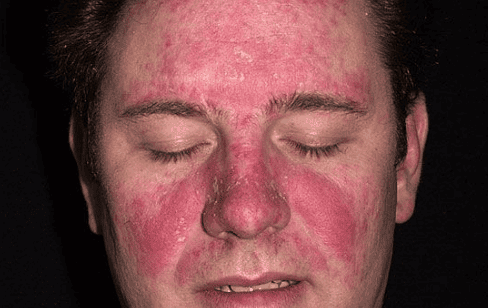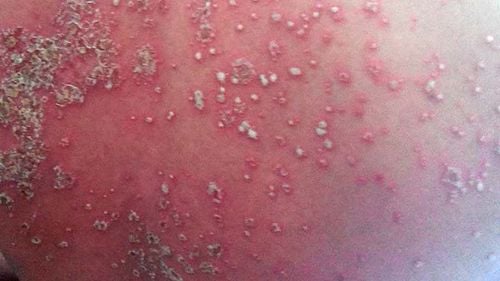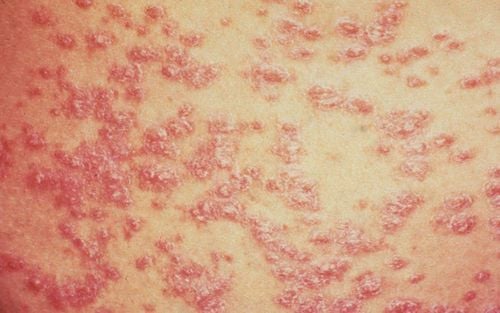This is an automatically translated article.
Pustular psoriasis is a condition in which non-infectious pustules appear on red patches of skin. Pustules are composed of white blood cells, this is not an infection, nor is it contagious.
1. Pustular psoriasis
Psoriasis is a skin condition where patches of red and scaly skin appear. Psoriasis can occur anywhere on the body, but is most commonly found around the knees and elbows. The condition occurs at any age, but the average age of onset is between 15 and 35 years old. The disease is uncommon in children under 10 years of age.
Psoriasis can appear in different forms. One of the types of psoriasis is pustular psoriasis that produces non-infectious pustules. Pustular psoriasis has pustules near or within the red skin spots.
Pustular psoriasis can occur in conjunction with other forms of psoriasis such as plaque psoriasis. It can flare up in single areas like the hands and feet, but rarely appears on the face.
Pustular psoriasis usually begins with an area of tender, red skin. Within hours, the large pus-filled blisters are not infectious. Eventually, these blisters turn brown. After they fall off, the skin becomes shiny or scaly.

Vảy nến mủ có thể kết hợp với các dạng vảy nến thể mảng bám
Types of pustular psoriasis
Von Zumbusch psoriasis can appear suddenly on the skin. The characteristic feature of Von Zumbusch psoriasis is the appearance of large, painful red areas of the skin. Within hours, pustules appear. Over the next 24 to 48 hours, the pustules dry up, leaving the skin shiny and smooth. Children rarely develop Von Zumbusch psoriasis. People with Von Zumbusch psoriasis often need to be hospitalized for rehydration and to start with topical and systemic treatment. Common symptoms of the disease include: fever, chills, severe itching, dehydration, fast heart rate, exhaustion, anemia, weight loss, and muscle weakness. Pustules on the palms - feet: cause pustules on the palms and soles. Pustules initially appear in a patchy pattern atop red patches of skin, but then turn brown, peel, and become brittle. The disease is often cyclical with new types of pustules followed by periods of low activity. People who smoke regularly have an increased risk of this disease. Acropustulosis is a rare type of psoriasis characterized by skin lesions on the fingertips and toes. The pain can make it difficult to use fingers or toes. In rare cases, it can damage nails or even bones. Factors that increase the risk of pustular psoriasis such as:
Certain medications Overexposure to UV rays Pregnancy Infection Stress

Tiếp xúc quá nhiều với tia UV cũng làm tăng nguy cơ mắc bệnh
2. Diagnosis
Pustular psoriasis is not a typical skin rash. Patients should see their doctor to receive the best treatment if a rash, blistering, or open wound does not improve or worsens.
Based on the patient's symptoms as well as medical history, family history of psoriasis, a dermatologist can diagnose the disease. In addition, the patient may need to do some more tests to accurately diagnose the condition such as:
Biopsy : The dermatologist will take a small sample of inflamed skin and put it under the microscope Blood test : to look for signs of white blood cell count, kidney and liver condition, electrolyte levels, calcium, etc. Sometimes, doctors will examine a sample of pustules to diagnose the condition.
3. Treatment
To effectively treat pustular psoriasis, doctors will depend on the type of pustular psoriasis you have. Treatments for various types of pustular psoriasis include:
Psoriasis Acropustulosis : The goal of treatment is to prevent infection, fluid loss, stabilize body temperature, and restore chemical balance of skin. Commonly prescribed medications: Acitretin, cyclosporine, methotrexate, oral PUVA (psoralen plus ultraviolet A light-sensitive drug), and TNF-alpha blockers such as infliximab. Pustules on the palms - feet : Indications for local treatment is the first step in treating pustules on the palms - feet. Your doctor may prescribe PUVA, ultraviolet B (UVB), acitretin, methotrexate, or cyclosporine.

Tùy loại bệnh vảy nến mủ mà bác sĩ sẽ kê toa thuốc điều trị phù hợp
Von Zumbusch Psoriasis: Treatments for the disease include antibiotics, rehydration, and topical creams. Treatment usually includes acitretin, cyclosporine, or methotrexate. Some doctors may prescribe steroids for people who have not responded to other treatments or are already seriously ill. But the use of these drugs is controversial because sudden steroid use can trigger Von Zumbusch pustular psoriasis. Your doctor may try phototherapeutic treatments, which use ultraviolet light on the inflamed skin. It is not uncommon for doctors to combine or rotate treatments for pustular psoriasis due to the potential side effects of systemic drugs and phototherapy.
Vinmec International General Hospital is one of the hospitals that not only ensures professional quality with a team of leading medical doctors, modern equipment and technology, but also stands out for its examination and consultation services. comprehensive and professional medical consultation and treatment; civilized, polite, safe and sterile medical examination and treatment space.
If you have a need for consultation and examination at the Hospitals of the National Health System, please book an appointment on the website for the best service.
Articles refer to sources: psoriasis.org, webmd.com, healthline.com
Please dial HOTLINE for more information or register for an appointment HERE. Download MyVinmec app to make appointments faster and to manage your bookings easily.













